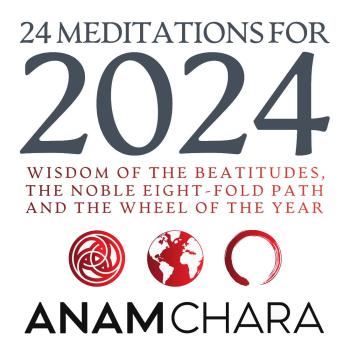A reader of this blog submitted this question:
How explicitly Christian does the prayer word need to be in contemplative prayer (e.g., Centering Prayer)?
My quiet-time practice is a hybrid of Lectio Divina with the Liturgy of the Hours. “No problem” with the three discursive steps of Lectio, but when I get to the non-discursive contemplatio, I struggle with monkey brain… Frankly, zazen’s breath counting “works” best for me over the years. I’ve tried using the Jesus Prayer, infused with my breathing. But I find that still too discursive (maybe I need to try it for more than six weeks?).
Thanks!
I know this is a technique question. But technique is what is getting in the way for me. Is zazen breath counting problematic for a Christian practitioner?
Thanks for your question. Here’s the short answer: yes, even your breath can function as your “sacred word.”
A Centering Prayer presenter who worked closely with Father Thomas Keating, David Frenette, wrote a lovely book called The Path of Centering Prayer: Deepening Your Experience of God. It’s well worth reading. As you might expect from a close associate of Keating, Frenette offers a fairly straightforward approach to the practice of silent prayer, consistent with the guidelines for Centering Prayer developed by Keating and Contemplative Outreach. But he is clear that the concept of the “sacred word” needs to be understood in as broad a way as possible. Thus, in addition to an actual word that we can silently recite whenever we find ourselves distracted by thought, Frenette offers insight into how we can deepen our prayer practice, not only with a word, but also with the breath, or a glance (as at a candle or an icon), or even the sheer experience of spacious silence, as types of “sacred words.” Devoting an entire chapter to “Deepening the Sacred Breath,” he writes:
…while the basic teaching on centering prayer generally focuses on the use of the sacred word, it is also possible to practice with other sacred symbols, including the sacred breath. Because the breath is such an embodied and receptive symbol, many people are drawn to practicing centering prayer with the sacred breath at certain seasons of the spiritual journey, to help with the deepening of their prayer into contemplation and as a way of integrating and embodying their spiritual practice with their physical, human experience.
This is not necessarily the same method as counting one’s breath, which is a common instruction for zazen. Technically speaking, if one is counting one’s breath, then the actual counting itself functions as the sacred word (one, two, three, etc.), rather than simply the breath itself. Remember, the sacred word is simply a gentle point of attention to which we can return whenever we are distracted during prayer by random thoughts, feelings, sensations or daydreams. Since any word can be used as your sacred word — it doesn’t have to be an explicitly religious or spiritual word — it’s certainly fine to use counting your breath in this way. But what Frenette is offering is something a bit more radical: allowing the breath itself to be that gentle point of attention, to which we return our focal point of awareness whenever the monkey-mind has become distracted.
This is not easy, and it might not be the best approach for beginners at centering prayer. A word, compared to the breath, might be an easier “anchor” for the awareness. But seasoned practitioners of centering prayer sometimes find that even a silently recited word feels distracting. As we learn to more stably remain attentive to objectless silence in our prayer, we may find that we need a more “silent” way of retrieving the wandering mind, when it wanders. Learning to simply place our attention on the breath — and to return it to the breath, as often as needed — can be a beautiful, deeply silent, ultimately very spacious practice of praying silently.

It may be helpful here to remind ourselves that centering prayer, unlike many other forms of meditative practice, does not use the sacred word as a mantra. In other words, the point is not simply to keep reciting the sacred word for the duration of your prayer time. Rather, you simply introduce the sacred word when, and only when, you notice that you have become distracted by thoughts, feelings, etc. It often happens, even to relative beginners, that we reach a graced place of simple, silent, objectless awareness as we pray. When that happens, the sacred word seems to simply fall away — and that is exactly what we are invited to do! Alas, such moments of graced silence often do not last very long — the thoughts keep wandering in to our awareness, like boats floating down a river, to use Keating’s famous analogy. So when we get caught up in another thought, which inevitably will happen, that’s when we return to the sacred word (or the attentiveness to the sacred breath. And only then.
Of course, the beauty of placing one’s attention on one’s breath during silent prayer is that we keep breathing, even when our attention is distracted… so in a way, the breath is very much like a mantra. But our engagement with the breath, like any other “sacred word,” is meant to be gentle, light, and spacious. We attend to it as much as we need to. At times, our attention to the breath may shade off into a more vast, objectless awareness, which is the true heart of the centering prayer. We’re still breathing of course, but it’s no longer the center of our attention. And then, along comes a thought, and noticing that, we return our attention to the breath. And this cycle of random thought > attentiveness to the breath or sacred word > graced moment of pure objectless awareness until distracted by another random thought continues for the duration of the centering prayer process.
So back to my reader. If counting your breath is the best sacred word for you, then count away. I also invite you to try to take your practice a bit deeper, by seeing if even the counting can be released, allowing simply the breath — our embodied sacrament of the presence of the Holy Spirit in your heart — to be your guide.
Enjoy reading this blog?
Click here to become a patron.


















